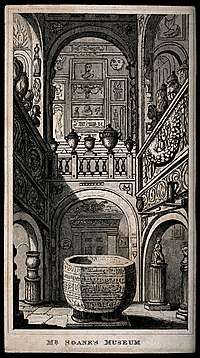Sarcophagus of Seti I
Sarcophagus of Seti I is a life-size sarcophagus of the 19th dynasty Pharaoh that was discovered in 1817 by the Italian explorer Giovanni Battista Belzoni in the Valley of the Kings, Egypt.[1] Seti I is believed to have died in 1279 BC and the sarcophagus would have housed his coffin and mummy.[2] It was bought by architect Sir John Soane in 1824 for £2000 (equivalent to £177,000 in 2019) after the British Museum turned it down citing Belzoni's steep price.[3] It is currently displayed in the crypt section, called Sepulchral Chamber, of Sir John Soane's Museum in London. Over 3000 years old, the sarcophagus is one of the oldest museum objects in the United Kingdom in public collection.[4]
| Sarcophagus of Seti I | |
|---|---|
 An 1834-35 engraving of the Sarcophagus of Seti I, on display at Sir John Soane's Museum | |
| Material | Alabaster with Egyptian blue infill |
| Size | Length 2.84 m Width (head): 55.9cm Width (feet): 81.3cm Height (shoulders): 81.3cm Height (lower part, feet): 68.6cm Thickness (lower part, sides): 2.5cm, minimum; 10.2cm, maximum |
| Writing | Egyptian hieroglyphs |
| Created | 1370 BC |
| Discovered | 1817 |
| Present location | Sir John Soane's Museum, London |
| Registration | M470 |
Bibliography
- Darley, Gillian (1999). John Soane: An Accidental Romantic. Yale University Press. ISBN 978-0-300-08165-7.CS1 maint: ref=harv (link)
References
- Rothstein, Edward (October 23, 2014). "Obsessive Visions on Display" – via NYTimes.com.
- "Sir John Soane's museum recreates architect's vision of pharaoh's tomb". the Guardian. November 5, 2017.
- Darley 1999, p. 274
- "7 of the oldest objects you'll find in London museums". Evening Standard. August 14, 2018.
External links
This article is issued from Wikipedia. The text is licensed under Creative Commons - Attribution - Sharealike. Additional terms may apply for the media files.